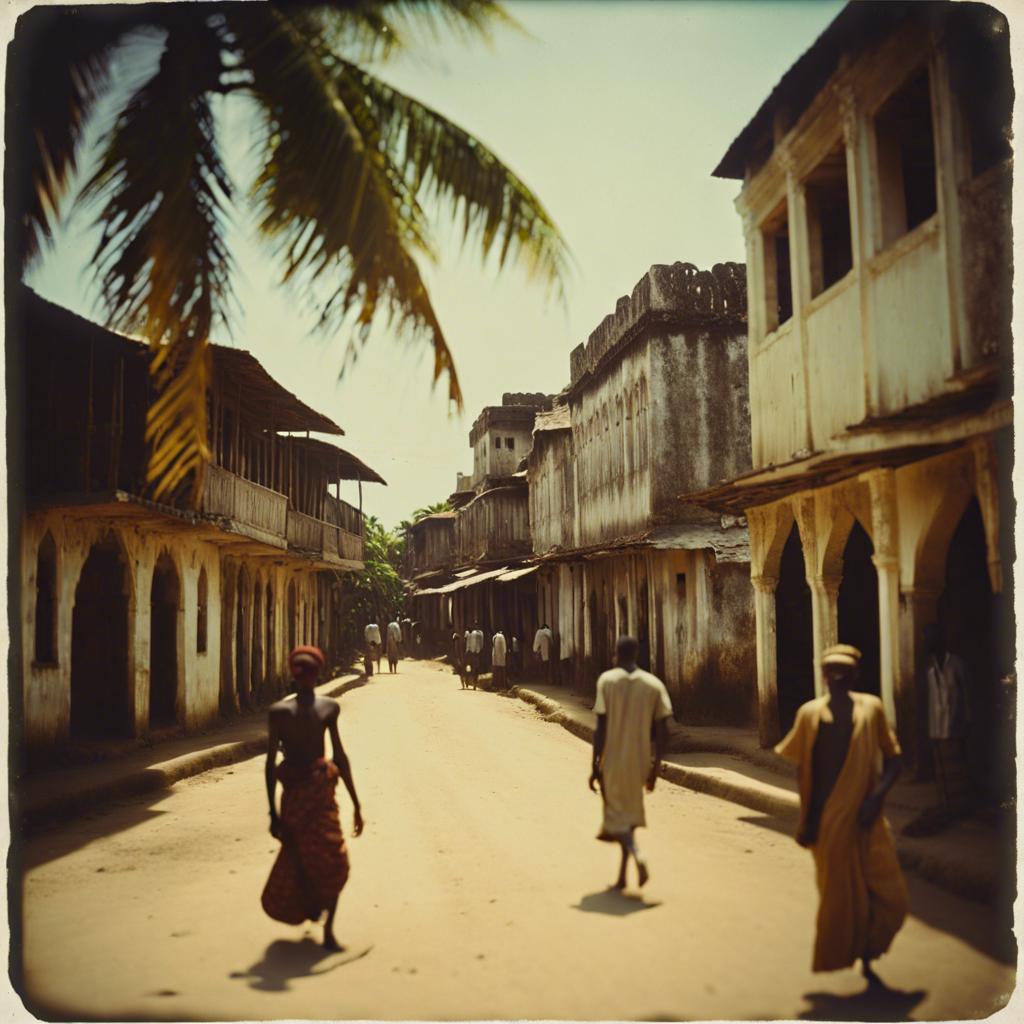Welcome to the enchanting island of Zanzibar, a place where history is not just studied but lived. Known for its rich tapestry of cultures and its pivotal role in both the spice trade and maritime explorations, Zanzibar offers a fascinating journey through time. Through our comprehensive guide at Tours-Zanzibar.com, we invite you to explore this historic island with us. Our carefully curated historical tours are designed to help travelers uncover the profound heritage and enduring charm of Zanzibar, from the winding alleyways of Stone Town to the remnants of ancient sultanates and the echoes of the spice trade winds. Join us to delve deeper into the past that shaped this unique island, making your trip not just a visit, but a discovery.
Exploring the Stone Town: A Walk Through Time
A Journey Through the Labyrinth of History
As you step into Stone Town, you are instantly transported back in time. The beating heart of Zanzibar, this old city is a maze of narrow alleys, flanked by ornately carved wooden doors and bustling bazaars. With Tours-Zanzibar.com, you can immerse yourself in the rich tapestry that has been woven by centuries of Swahili culture, Arabian influence, and European colonization.
Key Highlights of Our Stone Town Tour
- The House of Wonders: See the grand architecture and the towering pillars of Beit-al-Ajaib, originally built as a ceremonial palace.
- Forodhani Gardens: Experience the vibrancy of local life and enjoy Zanzibar’s famous street food market by the sea.
- Freddy Mercury’s Childhood Home: Visit the birthplace of the iconic Queen frontman, a site of pilgrimage for music lovers.
The narrow streets hold a treasure trove of stories, each corner echoing the diverse cultural influences melded over millennia. From traders and travelers to sultans and slaves, every step through this historical enclave reveals layers of its enigmatic past.
Architectural Marvels and Cultural Insights
| Site | Description | Historical Significance |
|---|---|---|
| Old Fort | A massive fortification that stands as a guardian of the town’s history | Built in the late 17th century, it’s the oldest building in Stone Town |
| Anglican Cathedral | Located on the site of the former slave market, featuring a striking altar | Memorializes the darkest chapters of Zanzibar’s history while celebrating its liberation |
Through Tours-Zanzibar.com, every whisper of the island’s history is revealed, making Stone Town not simply a destination, but a profound narrative to experience, cherish, and remember. Walk with us as we trace the lines of history, uncovering the soul of Zanzibar, inch by enigmatic inch.

The Role of Zanzibar in the Spice Trade
A Gateway of Aromas
Stepping onto the island of Zanzibar, one is immediately enveloped by the intoxicating scents of cloves, nutmeg, cinnamon, and black pepper. These are not just any spices; they are the remnants of Zanzibar’s historical backbone, which established the island as a central hub in the global spice trade. For centuries, Zanzibar attracted traders from across the world, seeking to harness its lush, fertile grounds for spice cultivation.
The Spice Farms of Zanzibar
With Tours-Zanzibar.com, explorers have the unique opportunity to visit working spice farms that continue to grow these aromatic treasures using traditional methods. This offers a hands-on experience where visitors can:
- Touch and taste different spices directly from the plants
- Learn about traditional and modern cultivation techniques
- Discover the medicinal and culinary uses of various spices
It is both an enlightening and sensory-expanding part of any historical tour, demonstrating the intricate connections between Zanzibar and global culinary landscapes.
From the Past to Present
Understanding is not merely about appreciating its past; it’s also about recognizing its ongoing influence in contemporary markets. The spice trade laid a foundational economic framework that supported Zanzibar’s economy throughout centuries. Today, a visit to the local markets provides vibrant testament to its enduring legacy. Ventures through these markets reveal:
| Spice | Description | Uses |
|---|---|---|
| Cloves | Dark, aromatic buds | Used in cooking and local medicine |
| Nutmeg | Hard seed with a mace-covered shell | Common in sweets and spice mixes |
| Cinnamon | Fragrant bark | Widely used in both savory dishes and desserts |
Exploring Zanzibar today offers a taste of both the past and how these practices are woven into the present, maintaining the island’s position on the spice map of the world.
Architectural Marvels: Ancient Palaces and Forts
Exploring Architectural Gems
Delve into a world where architecture tells tales of history and power on Tours-Zanzibar.com. Our expert-guided historical tours offer visitors an exceptional opportunity to explore some of the most stunning ancient palaces and forts, each echoing the rich cultural fusion distinctive to Zanzibar. From the gritty stones of ruins to the grandeur of beautifully preserved palaces, every site serves as a chapter in Zanzibar’s extensive historical narrative.
Mtoni Palace
Once a magnificent spectacle and residence to Sultan Seyyid Said and his family, Mtoni Palace offers a palpable sense of the 19th century Zanzibari royal lifestyle. Though now in ruins, this site allows us to imagine its past splendor, with botanical gardens that still hint at their former opulence. The palace’s charm is further enhanced by enthralling tales of its past residents, shared by our knowledgeable guides.
Ngome Kongwe (Old Fort)
Constructed in the late 17th century by the Omanis to fend off the Portuguese, Ngome Kongwe stands as a formidable symbol of the island’s strategic importance through ages. Currently a hub for cultural activities, the structure also hosts the Zanzibar International Film Festival. A walk within its thick walls and courtyards reveals stories of battles, trade, and the ebb and flow of political tides that have shaped the island.
Each tour crafted by Tours-Zanzibar.com ensures that participants not only see but also feel the historical impact through immersive storytelling and expert insights. Join us to uncover the architectural wonders of Zanzibar and step back into the echoes of its grand, tumultuous past.
Impact of the Slave Trade on Zanzibar’s History
Tracing the Shadows of the Past
Zanzibar’s modern vibrancy masks a tumultuous history, deeply engraved by the era of the slave trade. During the 19th century, this archipelago was East Africa’s main slave-trading port, a fact that has left an indelible mark on its cultural and economic landscape. Tours-Zanzibar.com takes you on a journey into this dark yet pivotal chapter of Zanzibar’s history, beginning at the infamous Stone Town, recognized as a UNESCO World Heritage site.
Key Sites of Memory
Our tour meticulously explores several pivotal sites:
- Slave Market Site: Once the heart of the slave trading empire, the site now hosts St. Monica’s Hostel and a poignant sculpture commemorating the lives affected by the slave trade. We delve into the stories of hardship and hope that emanate from this historic ground.
- Tippu Tip’s House: Named after the notorious slave and ivory trader, this residence offers a stark reminder of those who profited immensely from this inhumane trade. Understanding Tippu Tip’s influence helps to frame the complexity of historical narratives around wealth, power, and human exploitation.
- Slave Chambers: Hidden and cramped chambers where slaves were detained before auction provide a visceral connection to the past. The chambers’ somber confines evoke powerful emotions and a profound understanding of the human cost of the slave trade.
A Legacy of Resilience and Strength
As we navigate through Zanzibar’s stone-paved lanes and coral-stoned buildings, it becomes apparent how the island metamorphosed from a hub of human despair into a vibrant community synonymous with rich cultural diversity and strength. The sprightly rhythms of Taarab music—introduced by Sultan Seyyid Said from Oman, mingled with African influences, echo the stories of resilience and cultural amalgamation.
By exploring the tangible remnants of the slave trade with Tours-Zanzibar.com, visitors not only acknowledge the sorrows of the past but also embrace the resourcefulness and endurance of human spirit that shapes Zanzibar’s identity today.
Cultural Fusion: Swahili Influences and Colonial Legacies
Exploring the Intersections of Cultures
As you journey through Zanzibar with Tours-Zanzibar.com, you’ll discover a vivid tapestry woven with the threads of Swahili culture, alongside distinct imprints left by Portuguese, Omani, and British colonial rule. Each culture has contributed unique elements to the island, creating a rich cultural mosaic that’s palpable in daily life, architecture, and local customs.
Swahili Roots
The Swahili culture, intrinsic to the identity of Zanzibar, is best explored through its language, cuisine, and traditions. Our tours guide you through:
- Historic Stone Town, recognized as a UNESCO World Heritage Site, where Swahili architecture shines with intricately carved wooden doors and lattice work.
- Local markets brimming with spices—a nod to Zanzibar’s time as the center of the spice trade.
- Vibrant festivals that blend African music rhythms with Arabic tones, showcasing the island’s rich musical heritage.
Colonial Influence
The layers of colonial history are evident as you meander through the island. Highlights include:
- The Old Fort, built by the Omanis in the late 17th century to fend off Portuguese invaders, now serves as a cultural venue.
- Christ Church Cathedral, an Anglican church standing on the site of the old slave market, providing somber reflection on the island’s past.
Moreover, a fascinating reflection of colonial legacies can be seen in Zanzibar’s cuisine, where spices blend with traditional dishes, offering an array of flavors that tell tales of commerce, conquest, and fusion.
By understanding these cultures and histories, our tours don’t just recount facts—they immerse you in stories woven through the very streets and buildings of Zanzibar. Join us to peel back the layers of this enchanting island and gain insights that go beyond the typical tourist experience.
Preservation Efforts: Conserving Zanzibar’s Historical Sites
Guardians of Heritage
At the heart of Zanzibar’s appeal is its echo of antiquity, preserved across centuries-old buildings and narrow streets. As part of our commitment to sharing this historical tapestry with visitors, Tours-Zanzibar.com actively supports the local and international efforts aimed at maintaining these cultural treasures.
Strategic Conservation Initiatives
Key to the preservation process is the strategic partnership between government bodies, non-profit organizations, and the private sector. These include:
- The Stone Town Conservation and Development Authority (STCDA)
- Zanzibar Stone Town Heritage Society (ZSTHS)
- United Nations Educational, Scientific and Cultural Organization (UNESCO)
Each entity plays a pivotal role in the continuous restoration and conservation of sites such as the iconic House of Wonders and the ancient Old Fort. By participating in these tours, you contribute directly to the preservation efforts, ensuring that these historic landmarks endure for future generations.
Impact on Local Communities
The endeavor to preserve Zanzibar’s historical sites also significantly benefits the local communities. Restoration projects often employ local artisans and workers skilled in traditional construction techniques, sustaining not only the physical architecture but also the living heritage of building crafts in Zanzibar. Furthermore, the increased attention helps to boost local economies through tourism, providing improved amenities and infrastructure for residents.
| Sites Under Restoration | Community Benefits |
|---|---|
| Beit-al-Ajaib (House of Wonders) | Enhancement of local artisan skills |
| Old Fort (Ngome Kongwe) | Boost in local employment and tourism |
Thus, every walk through the winding alleys of Stone Town isn’t just a step back in time; it’s a step towards sustaining Zanzibar’s cultural legacy and enhancing the well-being of its local populace.
Guided Tours vs. Independent Exploration: What to Choose
Choosing Your Adventure Style
When planning your journey through the historical lanes of Zanzibar, deciding between a guided tour or venturing alone can significantly shape your experience. Guided tours, organized by reputed services like Tours-Zanzibar.com, offer a cohesive and educational approach. Tourists often appreciate the depth of insight and stories that a local guide contributes, turning ancient ruins and bustling markets into vivid chapters of Zanzibar’s past.
On the other hand, independent exploration appeals to those seeking a bit more spontaneity. This method allows you to absorb the island at your own pace, with opportunities to interact directly with the locals and perhaps uncover some off-the-beaten-path gems that are not typically highlighted in organized tours.
What Each Style Offers
| Guided Tours | Independent Exploration |
|---|---|
|
|
Whether you choose the structured guidance of a tour or the personal freedom of exploring on your own, both methods provide distinctive ways to engage with Zanzibar’s rich history. Consider what you hope to get out of your visit, who you’re traveling with, and your comfort level with navigating foreign environments when making your decision.
Recommendations for Authentic Local Experiences
Unlock the True Essence of Zanzibar with Our Unique Local Tours
At Tours-Zanzibar.com, we’re passionate about providing more than just standard sightseeing options. We strive to offer tours that unveil the soul of Zanzibar, engaging you deeply with the local environment and its traditions.
Explore Local Markets and Culinary Delights
- Stroll through vibrant marketplaces like the famous Darajani Market. Here, you can savor the aromatic spices that Zanzibar is famed for and perhaps pick up a few cooking tips from local vendors.
- Taste traditional Swahili dishes, such as Biryani or Urojo, from street food sellers who’ve perfected their recipes over generations.
Engage with Local Artisans
- Visit the workshops of local craftsmen in the winding alleys of Stone Town, where artisans invite visitors to watch as they intricately carve Zanzibar’s renowned wooden doors and furniture.
- Participate in a Tingatinga painting workshop. These workshops not only allow you to understand this iconic art form but also to create your own piece to take home as a unique souvenir.
In our quest to offer truly immersive experiences, Tours-Zanzibar.com ensures each itinerary is thoughtfully crafted to let you experience Zanzibar as a local, beyond the typical tourist path. From understanding the detailed history embedded in the ancient architecture to delving into the day-to-day lives of the local people, our tours are your gateway to a profoundly authentic Zanzibar adventure.
Concluding Remarks
In conclusion, venturing through the historical tours of Zanzibar not only offers a profound glimpse into the island’s vibrant past but also invites visitors to engage directly with its cultural and architectural heritage. From the winding alleys of Stone Town to the remnants of Omani sultanates and the poignant echoes of the slave markets, each locale provides a tangible connection to bygone eras. Whether you’re a history enthusiast or a curious traveler, Zanzibar presents a unique opportunity to immerse yourself in its rich tapestry of history, culture, and architecture. Understanding this past is not just about retracing the steps of those who walked the island before us, but also about appreciating the intricate blend of influences that shaped Zanzibar into the mesmerizing destination it is today. Remember, each visit contributes to the preservation and appreciation of these historical sites, ensuring they continue to educate and inspire generations to come.














